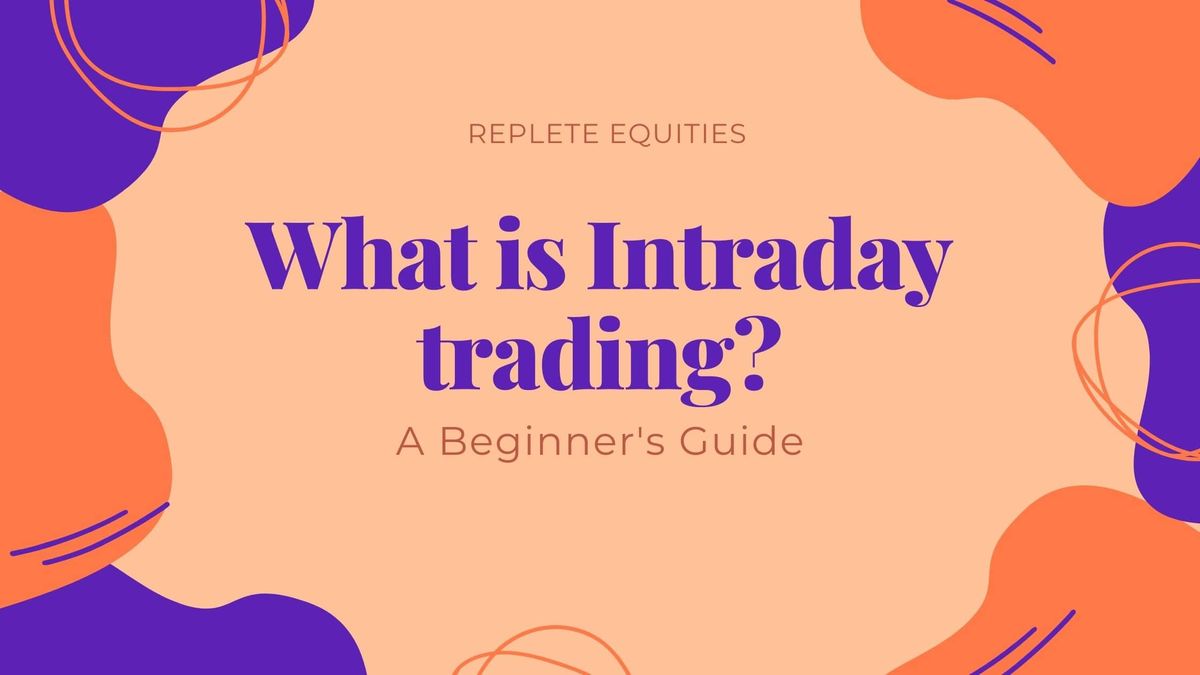What is Intraday Trading? The best guide for beginners in 2023

Hello guys. I hope you all are doing good. If you are a beginner and wanted to know what is intraday trading and how to do it? Then you are at the right place. In this article, I’m sharing a complete guide to Intra Day Trading and how beginners can do it and earn money easily. So read this post till the end to know how I trade in Intraday and which methods you can use to generate your daily return.
Some time ago the few individuals who had the option to trade effectively in the securities trade were those working for huge monetary foundations, financiers, and trade houses. But now, with the rise of the web and internet trade houses, it’s gotten simpler for the normal individual to get in on the game.
In this article, I will share what is intraday trading? and a beginner like you, how you can trade effectively. What methods you can use and what are the rules you should follow if you are trading intraday. So without wasting your time, let us jump to the first section i.e. what is intraday trading and how to trade it?
What is intraday trading and how to trade intraday?

Trading is the process of buying and selling stocks. Stocks are nothing but the quantities which contain some value and trading is made easier due to the advancement of financial and digital technology where anyone with a Demat account can trade or invest.
Demat account or De-materialised account is used to carry out the holding of investments, mutual funds, securities, government bonds, etc; virtually, unlike having a mandatory constraint to have physical bearings and documents.
Generally, a Demat account can be opened by anyone when possessing the required credentials as it is required in opening a normal bank account. The best thing about this account is that there are no physical documents involved except for photo scanning and every detail is digitalized and virtually enabled.
The authentication and validation are done using an E-sign and scanning of the physical documents of proof. This is usually done by stockbroking firms and financial service firms. These organizations help in providing an account and on proper validation and authentication of the documents, the account is approved for trade.
Rule-based Intraday Option Strategies for Nifty and BankNifty
What is Intraday trading?
Intraday trading can end up being an extremely rewarding form of trading and vice versa, it can also be somewhat trying for fledgelings—particularly for the individuals who aren’t completely set up with an all-around arranged system. Indeed, even the most prepared Intra-day traders can hit difficult situations and experience misfortunes. All in all, what precisely is Intra-day trading and how can it function?
First of all, Intra-day trading is nothing but the activity of trading that is the buying and selling of stocks within that trading day and within the time frame between market opening and closing which is from 9:15 am to 3:30 pm on all working days of the week.
Traders are dynamic dealers who use intraday methodologies to benefit from value changes for a given resource. Day trading utilizes multiple methods and techniques to exploit apparent market failures. Day trading is commonly described by specialized investigation and requires a serious level of patience and objectivity.
Traders are sensitive to occasions that cause transient market moves. Trade dependent on the news is a well-known method. Booked declarations like monetary measurements, corporate income, or loan costs are liable to advertise assumptions and market brain research. Markets respond when those assumptions are not met or are surpassed as a rule with unexpected, critical moves–which can enormously profit Intra-day traders.

Requirements for intraday trading:
Not only for intra-day trading but for any trade for that matter, there are certain things to be kept in mind before getting involved in it. It comprises of:
- Discipline and consistency.
- Proper research and experience in the market.
- Adequate risk-reward management.
- Capital for trade.
- Strategy and plan to trade.
- A stable and conscious mindset to trade.
- Avoid aggression and emotional trading-trading psychology.
How to start intraday trading?
Unlike other trading forms where the stock is upheld for a while, in intra-day trading, all the settlements are made within that trading day. Since it is a short form of trading, there are a lot of pre-calculations that go into it.
On the off chance that you are a dealer who knows about the securities trade and might want to attempt intraday trading, you can open another trading account to keep your intraday trading separated. Keeping separate records makes it simpler to monitor things.
You would then be able to use the correct tools that will assist you with intraday trades. After you have opened a trading account, you can get a few instruments to help you with the intraday trade. Before you start to trade, you need to invest some energy in analyzing day-by-day graphs so you can get familiar with the examples of value development.
Different devices give specialized examinations, and these might end up being helpful as well. There are also multiple strategies that modern-day traders consider to be effective for Intra-day trading.
Strategies for Intra-day trading:

- Scalping: This procedure endeavours to make various little benefits on little value changes for the duration of the day, and may likewise incorporate distinguishing brief trade openings.
- Reach trading: This technique essentially utilizes support and Resistance levels to decide buy and sell options. This trading style may likewise pass by the name of swing trading if positions are held for quite a long time instead of hours or days.
- High-Frequency Trading (HFT): these methodologies utilize refined calculations to abuse little or transient market failures up to a few thousand times in a solitary day.
- CFD strategy: Intraday trading is hectic and generating profit requires a lot of knowledge. But instruments like CFD are trader-friendly and easy to use. The CFD refers to the difference between the entry and exit points of a trade.
- Breakout trading strategy: In a breakout market strategy, a trader enters the market when the price goes beyond its resistance and support. Technical indicator volume is used by the traders to search such a pattern in the market. Breakouts need quick entries and exits. It does not involve waiting. The traders first calculate the breakout price level and wait for the breakout. This is a risky method of trading because after the breakout ends, there is none left for buying.
- Moving average crossover Strategy: This is a price crossover strategy in which when the price of the stocks goes above or below the moving average it gives the signal of path reversal. You can see the change in momentum when the price of a stock goes from one side of the moving average to the other side. A crossover below the moving average shows a downtrend while the crossover above the moving average shows the uptrend. This is considered one of the best Intraday trading strategies formulae.
What are the best candlestick patterns for Intraday trading?
The market trend is represented by various methods such as charts, trend graphs, candlesticks, etc. used to provide a visual representation of the market. This provides information regarding the movement and momentum of the market, the predictions of the market, and helpful for analysis to make the required proceedings on a trade. These patterns are vital to carry out an effective trade.
Candlestick patterns denote the strength of the market to validate if the buyers/sellers are more and prediction of the price of the stocks. There are multiple patterns to represent the dominance of buyers and sellers.
Most commonly used candlestick patterns for intra-day trading:
Doji Pattern:

These are the easiest to identify candlestick patterns as their opening and closing price are very close to each other. The candle thus looks like a plus sign with a chance that the highs and lows wicks of the candle being of different lengths. These are neutral patterns. However, they gain significance if they appear after a period of steady buying or selling. By itself, a Doji signals an end of the previous move.
As they open and close are near the same level, it signifies the end of buying in an uptrend and an end of selling in a downtrend. This does not necessarily mean that there will be a V-shaped move on the other side (this can be the case also), but brakes have been put to the previous trend. A Doji occurring in a range-bound movement has little significance.
Engulfing Pattern:

A two candle pattern, engulfing pattern is one of the most powerful patterns in candlesticks. It occurs when the second candle (latest candle) completely overshadows the previous candle or completely engulfs the previous candle. Symbolically it means that buyers have overpowered the sellers or vice versa.
There are two types of Engulfing patterns – Bullish Engulfing Pattern and Bearish Engulfing Pattern.
Bullish Engulfing Pattern:

As the name suggests a bullish engulfing pattern is a bullish indicator suggesting a possible up move. In this case, the second candle’s body (a bullish one) completely engulfs the previous day’s candle. Both the tails or wicks of the candle of the first bar are covered by the second candle.
The pattern suggests that bulls have taken over from the bears and are likely to start an up move. Such patterns are powerful if they are formed at the bottom of the correction in a bull move or near the bottom of a bear move. Such patterns are also seen at the end of consolidation.
Bearish Engulfing Pattern:

A bearish engulfing pattern is the opposite of its bullish cousin. It occurs near the top of an up move or at the top of a correction move in an overall bear market. The pattern signals that the bears have won the fight against the bulls and can push the stock downward.
The second candle (a bear candle) in a Bearish Engulfing Pattern engulfs the previous candle, which is smaller in size. Both the tails or wicks of the candle are covered (engulfed) by the bigger bear candle.
Morning Star Pattern:

A Morning star is a bullish three candle pattern that is formed at the bottom of a down move. The first candle in the morning star formation is a big bearish candle that clearly defines the down move. The second candle is a small candle, which is ideally a Doji candle. The third candle is a large bullish candle that closes near the top of the day.
The pattern signifies extreme selling as witnessed in the first candle, followed by a change of power as shown in the second candle and finally the bulls taking over and regaining lost ground.
Evening Star:

An exact mirror image of a Morning Star is an Evening Star. This occurs near the top of a rally and is a three candle formation. The first candle is a long bullish candle which is followed by a small candle which ideally should be a Doji candle. The third candle is a long bearish candle that signals the end of the bull move.
The formation signals the change in power from the rampaging bulls in the first candle who is stopped at the second candle with a change of power being witnessed in the small Doji candle. The third big bear candle betrays the winner and the possible move going forward.
Hanging Man:

Just like a two or three candle pattern, there are many one candle pattern that occurs at the tops and bottoms of the market move. Among these are Doji Hammer, Inverted Hammer, Shooting Star, and the Hanging Man. While all are equally significant in their appearance, we shall consider the Hanging Man, as it is an important pattern that appears near the top of the market.
This one candle pattern is formed at the end of an up move. The rally is near its exhaustion which leads to a sell-off in the opening hour of trading. The market, however, reverses and closes near the top, but it could either not cross the previous day’s high or it barely does. The morning sell-off suggests that the bull is losing control and may end up losing the fight going forward.
I have written a deep article about Best candlestick patterns for day trading. Check below link.
Join Trader’s Profit Hub for best support in live market
What are the best indicators for Intra-day trading?

In Trading, there is also an availability of a wide range of indicators and screeners used to predict and analyze the market. Especially for Intra-day trading, where the period and liquidity is less compared to long-term investments, there are many indicators used which may be a lagging or a leading indicator.
The most dominantly used indicators for Intra-day trading involves:
Moving Averages:

Moving averages is one of the most commonly used intraday trading indicators amongst intraday traders. In this method, the average closing rates are placed on a line on the stock chart over a specific period. Usually, the longer the period of the stock movement, the more reliable is the moving averages. This indicator helps a trader apprehend the price movement of the stock, as stocks are volatile.
Bollinger Bands:

Bollinger Bands are an advancement to moving averages. In this method, the average closing rates, an upper limit, and a lower limit are placed on 3 different lines on the stock chart over a specific period. These bands represent the stock’s standard deviation, i.e., the amount of increase or decrease of the price from its average.
Momentum Oscillators:

Since the stock market is very volatile, the prices constantly move up and down. There are instances when the stock market experiences a short-period cycle, despite the market not being bearish or bullish. A momentum oscillator helps traders to identify such scenarios. It helps to apprehend if the market sentiments are undergoing any modifications.
Relative Strength Index (RSI):

A trader uses the RSI indicator when he/she wants to compare the share price’s gains and losses. This information is then tabulated in an index form, with the RSI score ranging from 0 to 100. Usually, analysts tend to recommend traders to buy when the RSI reaches 70 and to sell when it reaches 30. Of course, not all stocks follow this pattern, so it is always suggested to do your research in advance.
Moving Average Convergence Divergence (MACD):

Momentum traders consider MACD as one of the most reliable and best indicators for intraday trading. This indicator provides information on trend direction, momentum, and duration. The MACD indicator is based on the convergence and divergence of two moving averages. A positive value of MACD means an upward trend, whereas a negative value indicates a negative trend.
How to understand the market behavior for intraday trading?
An Intraday trader regularly shuts all trades before the finish of the trading day. Fruitful day trade requires broad information and experience. Intra-day traders utilize an assortment of techniques to settle on trade choices.
Price unpredictability and normal day range are basic to an informal investor. Security should have adequate value development for an informal investor to accomplish a benefit. Volume and liquidity are likewise significant because entering and leaving trades rapidly are indispensable to catching little benefits per trade.
Protections with a little day-by-day reach or light day-by-day volume would not hold any importance with an informal investor. The number of day trades should establish over 6% of the edge record’s all-out trade movement during that five-day window.
What are trading psychology and emotional trading?

Intra-day traders are receptive to occasions that cause momentary market moves. Trade the news is a well-known method. Planned declarations like financial insights, corporate profit, or loan fees are liable to showcase assumptions and market brain research.
Markets respond when those assumptions are not met or are surpassed, normally with abrupt, huge moves, which can profit Intra-day traders.
Most autonomous Intra-day traders have brief days, working two to five hours out of every day. Frequently they will work on making mimicked trades for a while before starting to make live trades. They track their victories and disappointments versus the market, planning to learn by experience.
Alternately, fear makes dealers close out positions rashly to avoid the worry of huge losses. Fear is tangible during bear markets, and it is a strong feeling that can make brokers and financial backers act unreasonably to leave the market. It frequently transforms into an alarm, which causes critical selloffs in the market from alarm selling.
Risk management in Intra-day trading:
- Plan the trades.
- 1% rule- never endues more than 1% in a single trade.
- Have an effective stop-loss to minimize loss.
- Pre-calculative return expectation.
- Diversify and hedge the stocks.
Conclusion: What is Intraday trading?
Even though day trading has become fairly a disputable wonder, it tends to be a suitable method to acquire a benefit. Intra-day traders, both institutional and individual, assume a significant part in the commercial centre by keeping the business sectors effective and fluid. While day trading stays famous among unpracticed brokers, it ought to be left fundamentally to those with the abilities and assets expected to succeed.
Post your comments in the comment box if you have any query related to What is Intraday trading? and how to trade it? You can ask any question related to trading in the comment box.







